Taraxacum
| Dandelion | ||||||||||||||
|---|---|---|---|---|---|---|---|---|---|---|---|---|---|---|
A dandelion flower head composed of hundreds of florets.
|
||||||||||||||
| Scientific classification | ||||||||||||||
|
||||||||||||||
| Species | ||||||||||||||
|
See text |
Taraxacum is a large genus of flowering plants in the family Asteraceae. They are native to Europe, North America and Asia and two species, T. officinale and T. erythrospermum, are found as weeds worldwide.[1] The common name Dandelion is given to members of the genus and like other members of the Asteraceae family, they have very small flowers collected together into a composite flower head. Each single flower in a head is called a floret. Many Taraxacum species produce seeds asexually by apomixis, where the seeds are produced without pollination, resulting in offspring that are genetically identical to the parent plant.[2]
Contents |
Description
The species of Taraxacum are tap-rooted biennial or perennial herbaceous plants, native to temperate areas of the Northern Hemisphere of the Old World.
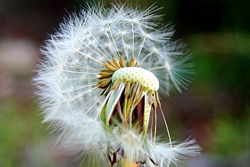
The leaves are 5–25 cm long or longer, simple and basal, entire or lobed, forming a rosette above the central taproot. The flower head, are yellow to orange colored, and are open in the daytime but closes at night. The heads are borne singly on a hollow stem (scape) which rises 4–75 cm[3] above the leaves and exudes a milky sap (latex) when broken. A rosette may produce several flowering stems at a time. The flower heads are 2–5 cm in diameter and consists entirely of ray florets. The flower heads mature into a spherical "clocks" (also known as a "wishie") containing many single-seeded fruits called achenes. Each achene is attached to a pappus of fine hairs, which enable wind-aided dispersal over long distances. The flower head is surrounded by bracts (sometimes mistakenly called sepals) in two series. The inner bracts are erect until the seeds mature, then flex downward to allow the seeds to disperse; the outer bracts are always reflexed downward. Some species drop the "parachute" from the achenes; the hair-like parachutes are called pappus, and they are modified sepals. Between the pappus and the achene, there is a stalk called a beak, which elongates as the fruit matures. The beak breaks off from the achene quite easily, separating the seed from the parachute.
Taxonomy
The genus is taxonomically complex, with some botanists dividing the group into numerous macrospecies, and many more microspecies: approximately 235 apomictic and polyploid microspecies have been recorded in Great Britain and Ireland[4]. Some botanists take a much narrower view and only accept a total of about 60 species.[5]
Selected species
- Taraxacum albidum, a white-flowering Japanese dandelion.
- Taraxacum californicum, the endangered California dandelion
- Taraxacum officinale (syn. T. officinale subsp. vulgare), Common Dandelion. Found in many forms.
- Taraxacum japonicum, Japanese dandelion. No ring of smallish, downward-turned leaves under the flowerhead.
- Taraxacum kok-saghyz, Russian dandelion, which produces rubber[6]
- Taraxacum laevigatum (syn. T. erythrospermum), Red-seeded Dandelion; achenes reddish brown and leaves deeply cut throughout length. Inner bracts' tips are hooded.
Seed dispersal
A number of species of Taraxacum are regarded as seed dispersed weeds or ruderals, especially the Common dandelion (T. officinale), which has been introduced over much of the temperate world as a lawn weed. After pollination and flowering is finished, the dandelion flower dries out for a day or two and then the seed-bearing parachutes expand and lift out of the dried flower head. The dried part of the flower drops off and the parachute ball opens into a full sphere. The parachute drops off when the seed strikes an obstacle. Often dandelions are observed growing in crevices near a wall; when the blowing fruits hit the wall, the feathery pappi comes off, dropping the dandelion seeds to the base of the wall or into a crevice. After the seed is released, the parachutes lose their feathered structure and take on a fuzzy, cotton-like appearance, often called "dandelion snow." Dandelions seeds are often dispersed by young children, who often blow on or kick the clock.
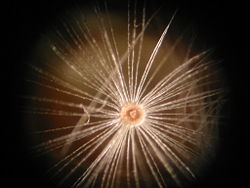
Dandelions are used as food plants by the larvae of some species of Lepidoptera (butterflies and moths). See List of Lepidoptera that feed on dandelions.
Away from their native regions, some dandelion species have become established in the Americas, Australia, and New Zealand, and are now common throughout all temperate regions, Taraxacum officinale has become a nearly world wide weed.
Seed development and genetics
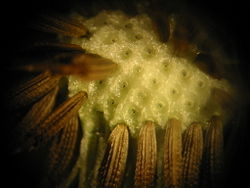
As previously mentioned, the taxonomical situation of the genus is quite complex, mainly because many dandelions are genetically triploid. An odd number of chromosomes usually is associated with sterility, but dandelions with this karyotype can reproduce without fertilization, by a process called apomixis.[7] In these individuals flowers are inefficient vestigial structures, although they may still produce a small percentage of fertile pollen, keeping some genetic contact with sexual individuals. Diploid dandelions develop seeds after cross-pollination and are outcrossing, or self-incompatible. In most zones of southern Europe and Asia, dandelion populations are sexual or mixed sexual-apomictic, while in northern countries only triploid and tetraploid apomicts are present, as is in the zones where it is not native. This seems to be linked to higher temperatures, survival of pre-glacial populations and human impact, but the subject is still being studied.
False dandelions
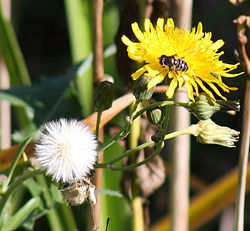
Dandelions are so similar to catsears (Hypochaeris) that catsears are also known as "false dandelions." Both plants carry similar flowers which form into windborne seeds. However, dandelion flowers are borne singly on unbranched, hairless and leafless, hollow stems, while catsear flowering stems are branched, solid and carry bracts. Both plants have a basal rosette of leaves and a central taproot. However, the leaves of dandelions are smooth or glabrous, whereas those of catsears are coarsely hairy.
Other plants with superficially similar flowers include hawkweeds (Hieracium) and hawksbeards (Crepis). These are both readily distinguished by their branched flowering stems which are usually hairy and bear leaves.
History
Dandelions are thought to have evolved about thirty million years ago in Eurasia[8]
They have been used by humans for food and herbalism for much of recorded history.
Origin of the name
The English name dandelion is a corruption of the French dent de lion[9] meaning lion's tooth, referring to the coarsely-toothed leaves. The names of the plant have the same meaning in several other European languages, such as Italian dente di leone, Spanish diente de león, Portuguese dente-de-leão, Norwegian Løvetann, and German Löwenzahn.
In modern French the plant is named pissenlit, which means "urinate in bed", apparently referring to its diuretic properties. Likewise, "pissabeds" is an English folkname for this plant, piscialletto in Italian and in Spanish it is known as the meacamas. Also, in various nort-eastern Italian dialects, it is known as pisacan, which translates to "dog pisses", referring to how common they are found at the side of pavements, while in many other northern Italian dialects, it is known as soffione, which translates to "blowing", and refers to the habit of blowing the seeds from the stalk. The same is valid for German, where "Pusteblume" (blowing flower) is a popular designation. Likewise, in Polish it is called "dmuchawiec" which comes from "dmuchać", "to blow" when in its seed state. Whilst in flower form the Poles know it as "Mlecz" a word derived from milk due to its milky sap.
In Turkish the dandelion is called karahindiba meaning "black endive".
Hungarian names are kutyatej ("dog milk", referring to the white sap found in the stem) and gyermekláncfű ("child's chain grass", referring to the habit of children to pick dandelions, remove the flowers, and make links out of the stems by "plugging" the narrow top end of the stem into the wider bottom end).
Lithuanian name kiaulpienė can be translated as "sow Sonchus" (because plant Sonchus that has white sap also in Lithuanian is pienė (from pienas "milk)) or "sow milk". In Finnish it is called 'voikukka' ("butter flower") referring to its buttery colour. In Swedish it is called 'maskros' ("worm rose"), likely referring to its low status (being mostly considered a weed) despite a fairly pleasant appearance.
In Dutch it is called paardebloem, meaning "horse-flower".

Antioxidant properties
Dandelion contains luteolin, an antioxidant, and has demonstrated antioxidant properties without cytotoxicity.[10][11]
Caffeic acid and carcinogenicity
Caffeic acid is a secondary plant metabolite produced in dandelion, yarrow, horsetail and whitethorn. Despite its name, it is unrelated to caffeine. Recent studies have revealed this acid may be carcinogenic. When caffeic acid was tested for carcinogenicity by oral administration in mice, renal cell adenomas appeared in females, and a high incidence of renal tubular cell hyperplasia occurred in animals of each sex.[12] However, more recent research shows that bacteria present in the rodents' intestines may alter the formation of metabolites of caffeic acid.[13][14] There have been no known ill effects of caffeic acid in humans.
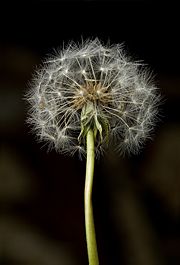
Bees
Dandelions are important plants for bees. Not only is their flowering used as an indicator that the honey bee season is starting, but they are also an important source of nectar and pollen early in the season.
Pearl bordered Fritillary
They are also used as a source of nectar by the Pearl-bordered Fritillary (Boloria euphrosyne), one of the earliest emerging butterflies in the spring.
References
- ↑ "Taraxacum". Flora of North America.
- ↑ Dandelion - J. Doll and T. Trower
- ↑ Taraxacum latilobum in Flora of North America @ efloras.org
- ↑ Richards, A.J. (1997). Dandelions of Great Britain and Ireland (Handbooks for Field Identification). BSBI Publications. pp. 330. ISBN 978-0901158253.
- ↑ http://www.jstor.org/pss/2430530
- ↑ "Plants for a future: Taraxacum kok-saghiz".
- ↑ http://fieldcrop.msu.edu/documents/GR03-050.pdf
- ↑ Gardening in Western Washington: Dandelions
- ↑ S. Potter & L. Sargent (1973) Pedigree: essays on the etymology of words from nature. Collins New Naturalist series Volume 56
- ↑ Chun Hu and David D. Kitts. Food, Nutrition and Health, Faculty of Agricultural Sciences, University of British Columbia, Vancouver, BC, Canada. October 2004. Luteolin and luteolin-7-O-glucoside from dandelion flower suppress iNOS and COX-2 in RAW264.7 cells. Springer Netherlands. 245:1-2(107-113).
- ↑ Luteolin and luteolin-7-O-glucoside from dandelion flower suppress iNOS and COX-2 in RAW264.7 cells
- ↑ Caffeic acid phenethyl ester is a potent and specific inhibitor of activation of nuclear transcription factor NF-kappa B., Natarajan K, Singh S, Burke TR Jr, Grunberger D, Aggarwal BB., Proc. Natl. Acad. Sci. U S A., 1996 Aug 20;93(17):9090-5.
- ↑ Caffeic Acid Metabolism by Gnotobiotic Rats and their Intestinal Bacteria
- ↑ Chlorogenic Acid Bioavailability Largely Depends on Its Metabolism by the Gut Microflora in Rats
External links
- Everitt, J.H.; Lonard, R.L., Little, C.R. (2007). Weeds in South Texas and Northern Mexico. Lubbock: Texas Tech University Press. ISBN 0-89672-614-2
- Richards, A. J. 1972. The Taraxacum flora of the British Isles. Watsonia 9 (supplement): 1-141.
- Gail, Peter. The Dandelion Celebration: A Guide to Unexpected Cuisine. Cleveland, Ohio: Goosefoot Acres Press, 1994. ISBN 1-879863-51-0.
- How to cook dandelions ~ at Wikibooks
- How to Get Rid of Dandelions
- How to Grow Dandelions
- Timelapse video of dandelions opening
- Hu, Chun (2004). "Luteolin and luteolin-7-O-glucoside from dandelion flower suppress iNOS and COX-2 in RAW264.7 cells". Molecular and Cellular Biochemistry 265: 107. doi:.
See also
- List of beneficial weeds
- List of companion plants